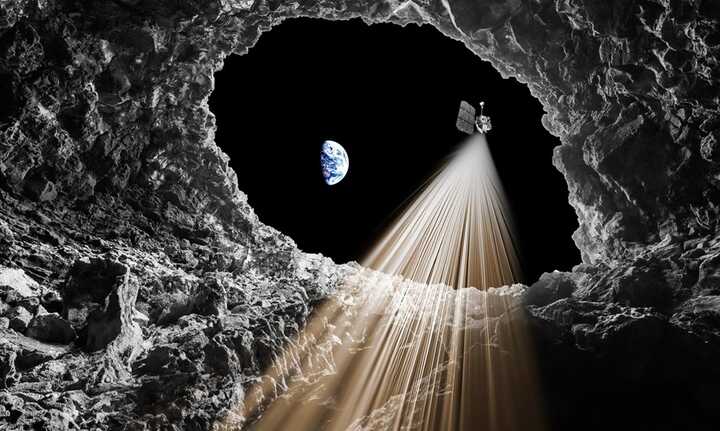
Researchers find evidence for cave accessible from surface – which could shelter humans from harsh lunar environment
Researchers have found evidence for a substantial underground cave on the moon that is accessible from the surface, making the spot a prime location to build a future lunar base.
The cave appears to be reachable from an open pit in the Mare Tranquillitatis (Sea of Tranquility), the ancient lava plain where the Apollo 11 astronauts Neil Armstrong and Buzz Aldrin first set foot on the moon more than half a century ago.
Analysis of radar data collected by Nasa’s lunar reconnaissance orbiter (LRO) revealed that the Mare Tranquillitatis pit, the deepest known pit on the moon, leads to a cave 45 metres wide and up to 80 metres long, an area equivalent to 14 tennis courts. The cave lies about 150 metres beneath the surface.
Lorenzo Bruzzone, of the University of Trento in Italy, said the cave was “probably an empty lava tube”, adding that such features could serve as human habitats for future explorers as they were “a natural shelter against the harsh lunar environment”.
Lunar orbiters first spotted pits on the moon more than a decade ago. Many are thought to be “skylights” that connect to underground caves such as lava tubes, giant underground tunnels that form through volcanic processes.
Such caves could form the basis for a moonbase or an emergency lunar shelter because the temperature is relatively stable inside and astronauts would be naturally shielded from harmful cosmic rays, solar radiation and micrometeorites.

Many lunar pits are thought to connect to underground caves such as lava tubes, giant underground tunnels that form through volcanic processes. Photograph: NASA
Previous images taken from the LRO showed that the bottom of the Mare Tranquillitatis pit was strewn with boulders up to 10 metres wide. But it was unclear whether the pit was enclosed or served as an entry point to an underground cave, such as a lava tube whose roof had collapsed.
Writing in Nature Astronomy, the scientists describe how they used LRO data and computer simulations to show that the 100 metre-wide pit, which is bordered by vertical or overhanging walls, leads to a sloping floor and a cave that extends for tens of metres westwards.
Researchers are keen to study the rocks inside such caves as they are likely to hold clues to the moon’s formation and volcanic history. The caves may also contain water ice, a resource Bruzzone said was essential for long-term lunar missions and colonisation.
At least 200 pits have been spotted on the moon and many found on lava fields could be entrances to cavernous subterranean lava tubes. “The main advantage of caves is that they make available the main structural parts of a possible human base without requiring complex construction activities,” said Leonardo Carrer, the study’s first author.
In preparation for humans returning to the moon, space agencies are already wondering how to assess the structural stability of caves and reinforce their walls and ceilings. Habitats may also need monitoring systems to warn of movement or seismic activity and have separate areas for astronauts to retreat to should sections of their cave collapse.
“Lunar cave systems have been proposed as great places to site future crewed bases, as the thick cave ceiling of rock is ideal to protect people and infrastructure from the wildly varying day-night lunar surface temperature variations and to block high energy radiation which bathes the lunar surface,” said Katherine Joy, professor in earth sciences at the University of Manchester. “However, we currently know very little about the underground structures below these pit entrances.”
Robert Wagner, a researcher at Arizona State University, said one of the biggest challenges would be access. “Getting into that pit requires descending 125 metres before you reach the floor, and the rim is a steep slope of loose debris where any movement will send little avalanches down on to anyone below,” he said. “It’s certainly possible to get in and out, but it will take a significant amount of infrastructure.”
Read more similar news:
Comments:
comments powered by Disqus

































